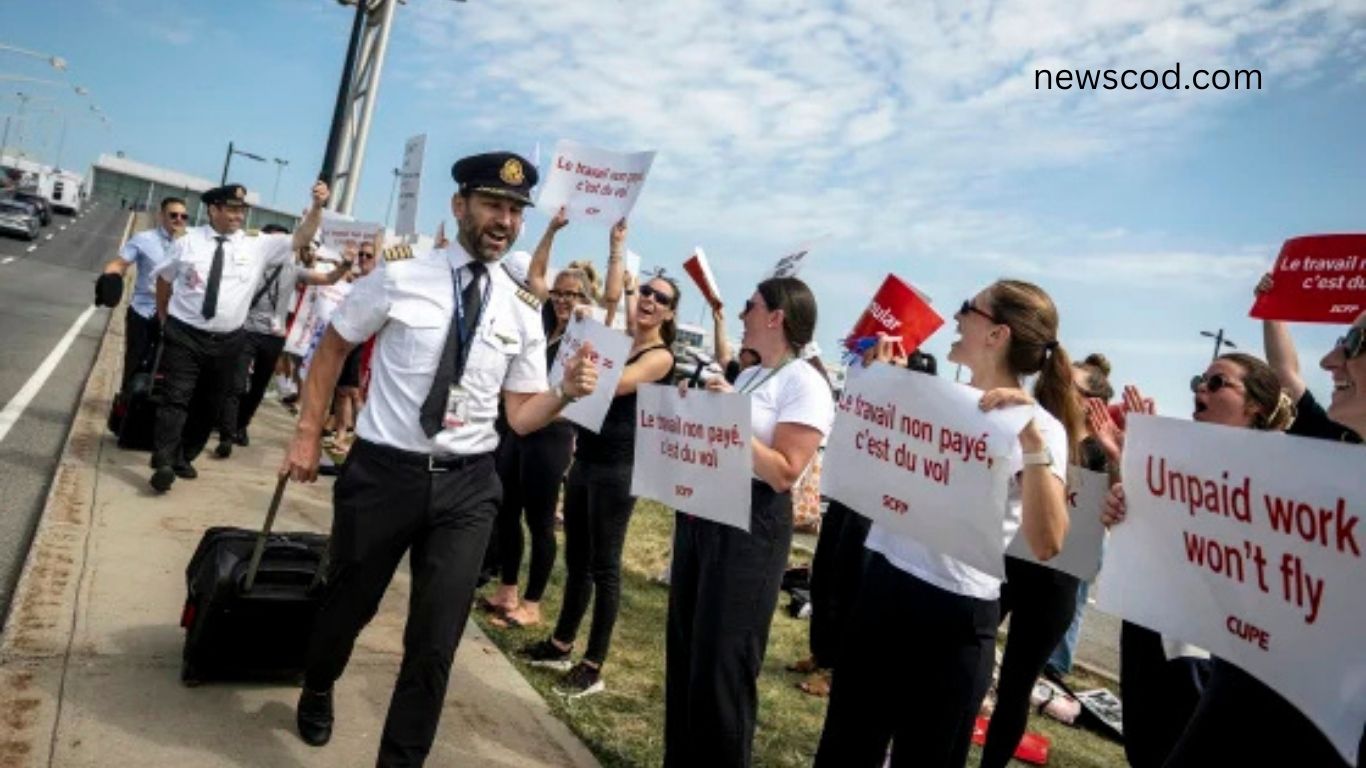The tense labor dispute between Air Canada and its flight attendants has come to a temporary close, with both sides confirming early Tuesday that a tentative agreement has been reached. The announcement ended a disruptive strike that began Saturday and grounded hundreds of thousands of passengers across the country and abroad.
The Canadian Union of Public Employees (CUPE), which represents more than 10,000 Air Canada and Air Canada Rouge flight attendants, announced the breakthrough in a social media post. “The strike has ended,” the union declared, urging members to “fully cooperate with resumption of operations.”
Air Canada also confirmed the agreement, stating that operations would begin to restart gradually on Tuesday. However, the carrier warned that restoring its full schedule could take at least a week, as crews, aircraft, and passengers slowly return to normal patterns.
“The suspension of our service is extremely difficult for our customers,” said Michael Rousseau, Air Canada’s President and CEO. “We deeply regret and apologize for the impact on them of this labor disruption.”
Read More: India’s clash with Pakistan sees use of Chinese missiles, French jets and Israeli drones
How the Strike Began
The strike, which officially started in the early hours of Saturday, stemmed from unresolved disputes over pay, scheduling, and working conditions. Flight attendants argued that wages had not kept pace with inflation and that scheduling practices placed unsustainable demands on staff.
By Sunday, the Canadian Industrial Relations Board ordered flight attendants back to work after Jobs Minister Patty Hajdu invoked binding arbitration. This meant the existing contract would remain in place until a new deal could be negotiated. Despite this directive, CUPE called the government’s move unconstitutional and initially vowed to continue the strike.
Union leaders accused Ottawa of siding with the airline. “This is a disgraceful misuse of power that reeks of systemic bias and corporate favoritism,” said Candace Rennick, CUPE’s national secretary-treasurer.
The Impact on Travelers
The disruption was massive. Air Canada estimated that more than 500,000 passengers were affected by flight cancellations and delays over the three-day walkout. Airports across Canada, from Toronto Pearson to Vancouver International, saw long lines, rebooked flights, and frustrated travelers scrambling for alternatives.
International routes were especially hard hit, with many transatlantic and transpacific flights grounded. Passengers were left with limited options as other carriers were quickly booked up. Tourism officials and business leaders expressed concern about the wider economic impact, particularly during peak summer travel.
Government Intervention and Legal Battles
The government’s decision to impose binding arbitration reflects Ottawa’s increasing willingness to intervene in major transportation labor disputes. Over the past decade, similar measures have been taken in disputes involving railways and airlines to prevent extended shutdowns that could cripple Canada’s economy.
However, labor advocates argue that such interventions undermine workers’ bargaining power and weaken the right to strike. CUPE’s leadership signaled it may challenge the government’s order in court, even as it works toward finalizing a new contract under arbitration.
Why the Agreement Matters
The tentative deal brings relief to passengers, but it also raises questions about the future of labor relations in Canada’s aviation sector. With inflation, rising living costs, and post-pandemic workload pressures, flight attendants and other airline employees have increasingly pushed for stronger protections and fairer compensation.
For Air Canada, the strike underscores vulnerabilities in its operations. The airline, which is still recovering from pandemic-era losses, faces pressure to balance labor costs with profitability. Prolonged disruptions risk eroding customer confidence, especially at a time when many travelers already feel frustrated by flight delays, cancellations, and high ticket prices.
Broader Labor Context in Canada
The Air Canada dispute is not an isolated case. Across North America, unions representing transportation workers have become more assertive in demanding better pay and working conditions. From U.S. airline pilots to Canadian rail workers, labor groups are leveraging tight labor markets to press for gains.
For CUPE, Canada’s largest union, the Air Canada standoff represents a high-profile test of its influence. The union represents workers across multiple industries, but flight attendants form one of its most visible groups. A successful outcome could strengthen CUPE’s bargaining position in future disputes, while a weak settlement could spark frustration among members.
Frequently Asked Questions:
Why did Air Canada flight attendants go on strike?
Flight attendants walked off the job over disputes related to pay, scheduling, and overall working conditions.
How long did the Air Canada strike last?
The strike began early Saturday and ended Tuesday after a tentative deal was reached, though operations will take time to return to normal.
How many passengers were affected by the strike?
Air Canada estimated that over 500,000 customers experienced cancellations or disruptions during the strike.
What role did the Canadian government play in the strike?
The government imposed binding arbitration through the Canadian Industrial Relations Board, requiring flight attendants to resume work while negotiations continued.
What did the union say about the government’s involvement?
The Canadian Union of Public Employees (CUPE) criticized the order as unconstitutional, accusing Ottawa of siding with the airline.
What happens next after the tentative agreement?
The deal must be ratified by union members. Full details will be shared once voting begins, which may take several weeks.
When will Air Canada resume normal flight operations?
Air Canada has begun gradually restoring flights but warned that full service recovery could take a week or more.
Conclusion
The tentative agreement between Air Canada and its flight attendants has brought relief to travelers and stability to Canada’s largest airline, at least for now. While the strike highlighted long-standing tensions over pay and scheduling, it also underscored the critical role of flight attendants in keeping operations running smoothly. The government’s intervention and the union’s strong pushback reflect broader debates about labor rights and corporate responsibility in the aviation sector.

